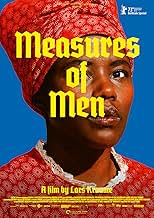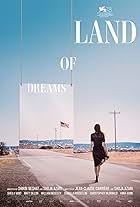End of 19th century German ethnologist Hoffmann travels to the former colony "German Southwest Africa" to gather art and skulls for the Berlin Ethnological Museum and slowly begins to lose h... Read allEnd of 19th century German ethnologist Hoffmann travels to the former colony "German Southwest Africa" to gather art and skulls for the Berlin Ethnological Museum and slowly begins to lose his moral compass.End of 19th century German ethnologist Hoffmann travels to the former colony "German Southwest Africa" to gather art and skulls for the Berlin Ethnological Museum and slowly begins to lose his moral compass.
- Awards
- 1 nomination
Photos
- Director
- Writer
- All cast & crew
- Production, box office & more at IMDbPro
Storyline
Featured review
Set in the end of 19th century, Deutchsland, Alexander Hoffman (Leonard Scheicher) is an anthropology student with aspirations to become a well-known scientist and professor. Along the way, he befriends an intelligent African-native, Kezia Kambazembi (Girley Jazama). Then German ethnologist Hoffmann travels to the former "German Southwest Africa" colony to gather art and skulls for the Berlin Ethnological Museum and slowly begins to lose his moral compass. Addressing this colonial crime story through Hoffman, a young man who wants to become an ethnologist and study native men in an era led by racist and immoral currents of thought, which later will have influence in Nazi doctrines and the appearance of the most evil character in history: Hitler. However, the way of understanding 'the other' changes for our protagonist when he meets a woman of the Herero ethnic group. The Herero were a tribe of pastoralists who lived in a region of German South West Africa, in modern Namibia. The area occupied by the Herero was known as Hereroland.
Premiered at 2023 Berlin Film Festival, this intense drama deals with the genocide carried out by imperial German troops in German South West Africa, present-day Namibia, between 1904 and 1908. The film has an acid critic to the racism, colonialism, abuse of power and indolence of European nations and international community. Lars Kraume, director of this splendid film, shows the horrors, the agony and the suffering to which some African ethnic groups, such as the Herero, were subjected, in the midst of the distribution of African territory by the European colonial powers.
The movie has a colorful and evocative cinematography, being filmed on location in Namibia. As well as a touching and enjoyable musical score. This sad motion picture was compellingly directed by Lars Kraume who also directed other thought-provoking films, such as: "The Silent Revolution", "Bauhaus - A New Era", "The Coming Days", and "The People vs. Fritz Bauer".
Adding more details to those explained in the film: During the division of Africa, the British made it clear that they were not interested in the territory, therefore, in 1884, a German protectorate was declared and, at that time, the only overseas territory considered suitable for white colonization that Germany had acquired. From the beginning, there was resistance to German occupation, despite a tenuous peace formed in 1894. In that year, Theodor Leutwein became governor of the territory, beginning a period of rapid development for the Khoikhoi colony, while Germany sent the Schutztruppe, colonial or imperial troops, to dominate the region. European settlers were encouraged to settle on native lands, which caused great discontent. In the following ten years, the land and livestock that were essential for the subsistence of the Herero and Namaqua passed into the hands of the Germans who arrived in the colony. The German colonial regime was far from egalitarian; natives were used as slaves and their lands were frequently confiscated and given to settlers.
The genocide of the Herero and Nama occurred in German Southwest Africa (present-day Namibia) from 1904 to 1907, during the partition of Africa. It is considered to be the first genocide of the 20th century. On January 12, 1904, the Hereros, led by chief Samuel Maharero, rebel against German colonial rule. In August General Lothar von Trotha defeated the Hereros at the Battle of Waterberg and pursued them through the Omaheke Desert, where most of the Hereros died of dehydration. In October the Namaquas also took up arms against the Germans and were treated in a similar manner. In total between twenty-four thousand and sixty-five thousand Hereros (approximately 50% or 70% of the total Herero population), and ten thousand Namaquas (50% of the total Namaqua population) perished. Three events characterized this genocide: death by starvation, the poisoning of the wells used by the Herero and Namaqua, and the rounding up of the natives in the Namibian desert. These events are well depicted in the film.
Premiered at 2023 Berlin Film Festival, this intense drama deals with the genocide carried out by imperial German troops in German South West Africa, present-day Namibia, between 1904 and 1908. The film has an acid critic to the racism, colonialism, abuse of power and indolence of European nations and international community. Lars Kraume, director of this splendid film, shows the horrors, the agony and the suffering to which some African ethnic groups, such as the Herero, were subjected, in the midst of the distribution of African territory by the European colonial powers.
The movie has a colorful and evocative cinematography, being filmed on location in Namibia. As well as a touching and enjoyable musical score. This sad motion picture was compellingly directed by Lars Kraume who also directed other thought-provoking films, such as: "The Silent Revolution", "Bauhaus - A New Era", "The Coming Days", and "The People vs. Fritz Bauer".
Adding more details to those explained in the film: During the division of Africa, the British made it clear that they were not interested in the territory, therefore, in 1884, a German protectorate was declared and, at that time, the only overseas territory considered suitable for white colonization that Germany had acquired. From the beginning, there was resistance to German occupation, despite a tenuous peace formed in 1894. In that year, Theodor Leutwein became governor of the territory, beginning a period of rapid development for the Khoikhoi colony, while Germany sent the Schutztruppe, colonial or imperial troops, to dominate the region. European settlers were encouraged to settle on native lands, which caused great discontent. In the following ten years, the land and livestock that were essential for the subsistence of the Herero and Namaqua passed into the hands of the Germans who arrived in the colony. The German colonial regime was far from egalitarian; natives were used as slaves and their lands were frequently confiscated and given to settlers.
The genocide of the Herero and Nama occurred in German Southwest Africa (present-day Namibia) from 1904 to 1907, during the partition of Africa. It is considered to be the first genocide of the 20th century. On January 12, 1904, the Hereros, led by chief Samuel Maharero, rebel against German colonial rule. In August General Lothar von Trotha defeated the Hereros at the Battle of Waterberg and pursued them through the Omaheke Desert, where most of the Hereros died of dehydration. In October the Namaquas also took up arms against the Germans and were treated in a similar manner. In total between twenty-four thousand and sixty-five thousand Hereros (approximately 50% or 70% of the total Herero population), and ten thousand Namaquas (50% of the total Namaqua population) perished. Three events characterized this genocide: death by starvation, the poisoning of the wells used by the Herero and Namaqua, and the rounding up of the natives in the Namibian desert. These events are well depicted in the film.
- How long is Measures of Men?Powered by Alexa
Details
- Release date
- Country of origin
- Language
- Also known as
- La ambición de los hombres
- Filming locations
- Production companies
- See more company credits at IMDbPro
- Runtime1 hour 56 minutes
- Color
Contribute to this page
Suggest an edit or add missing content























